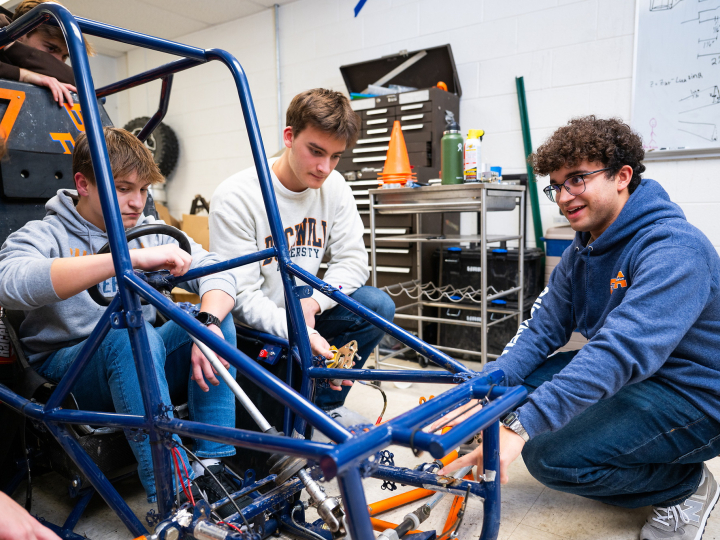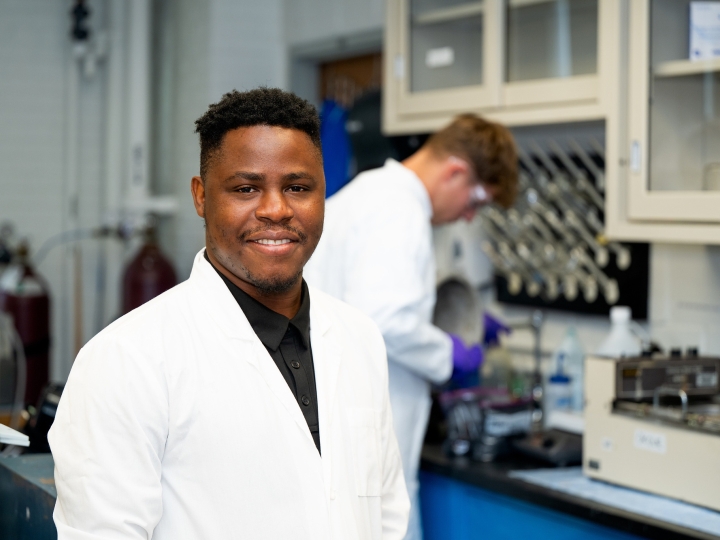Believing the Hyperloop Hype
March 2, 2016
Ever since technology mogul Elon Musk unveiled his idea for the Hyperloop — a theoretical mass-transit system that would propel passengers and cargo through vacuum tubes at near-supersonic speeds — the concept has been met with both buzz and skepticism.
Engineers at Bucknell have taken the proposal seriously, at least as an idea worth exploring, and have been studying aspects of Musk's idea almost since he unveiled it. On a weekend in late January, a team from the University was among those Musk invited to an international gathering in Texas to help prove his critics wrong.
Musk, the co-founder of PayPal and CEO of Tesla Motors and SpaceX, put forth his ambitious idea for a "fifth mode of transportation" in a 2013 white paper, which made the technical details freely available.
Musk's SpaceX doesn't plan to build the Hyperloop, but it is offering support to those working to develop the idea, in ways that include hosting a January design weekend at Texas A&M University. A team from Bucknell was among roughly 120 groups — including universities, private companies and nonprofits — from around the world selected to present their ideas for the Hyperloop at the conference.
In a Hyperloop as Musk envisions it, pods containing passengers or freight levitate in a near-vacuum inside hollow tubes. Powered by solar panels and nearly free of friction, the pods could reach speeds of 760 miles per hour, more than double the speed of the fastest existing high-speed trains.
Bucknell students began investigating the concept not long after Musk offered up the idea. Last year, one of Mechanical Engineering Professor M. Laura Beninati's students proposed an investigation of some of the Hyperloop's underlying ideas as his senior design project — a capstone experience all senior engineering majors must complete.
After SpaceX announced the Texas gathering in June 2015, Beninati and Professor Steven Covey, mechanical engineering, decided to again offer the Hyperloop as an option for senior design projects, with the understanding that students working on the project would submit their work for inclusion. The team of senior mechanical engineering majors Ben Burgess, Cody Haupt, Garrett Powell, Deanna Godby, Shane O'Donnell, Robert Cozza and Sean Hooper took on the challenge.
They joined more than 1,000 teams in submitting letters of intent to participate in the competition, and about 400 in submitting final proposals. After they were selected, Burgess, Haupt, Powell and Godby traveled to Texas to represent the team together with Covey, who served as a judge of the competition.
"It was pretty prestigious just to be selected," said Beninati, who advises the group with Covey. "Teams applied from all over the world."
The Bucknell team's contribution to the Hyperloop project was to examine the viability of Hyperloop's most futuristic subsystem, its levitation drive. The most practical way to make the pods float, they decided, was to employ the existing technology of air bearings. As Powell explains it, an air bearing operates by the same principals as an air hockey table, except that the air is forced through the puck, rather than the table.
"It creates a film of air that's able to support a heavy load," Powell said.
The technology is already used in heavy industry to move massively heavy loads, but it's never been tested in a high-speed application like Hyperloop. The Bucknell team put its efforts into testing whether the bearings really could work at more than 700 miles per hour.
"Some teams really focused on aesthetics, but didn't do much mathematical proofing to verify their design would even work," said Haupt. "We really focused on making sure the idea would work, and put a lot of time into our test setup and procedure."
On-campus development of the team's design was supported by a grant from the Kern Family Foundation, while funding for travel to the conference was provided by the College of Engineering, the mechanical engineering department, the Oliver/Walters Family Endowment for Mechanical Engineering and the Terry J. Hibbard Mechanical Engineering Endowment.
The team was not eligible to move on to the next stage of the competition this summer because they didn't design an entire pod, but the Bucknell students still found the weekend worthwhile and alive with possibilities. In addition to presenting their project and seeing what other teams designed, the students got to attend a surprise Q&A session with Musk — who told the crowd, "It's clear that the world and the public wants something new, and I think you guys are going to bring it to them" — as well as to hear a keynote address by U.S. Transportation Secretary Anthony Foxx.
"(Foxx) addressed the point that this is going to face a lot of skepticism, a lot of criticism, and it's going to be hard to work it into the existing system of land, air, sea and rail," Burgess said. "But it's not like these challenges haven't been faced before, and this could really be the brink of something huge. He saw as much as anyone that we are on the brink of making history."
So, has the team bought into the Hyperloop hype? Will we ever see the system constructed?
"It might be down the road a ways, but one thing (Foxx) said a lot was that this moment was pivotal, because everyone was coming together with ideas," said Burgess.
"When we went to this competition we realized that this is happening, this is real," added Godby. "Musk could host one of these competitions every year, and with each competition, you're going to get closer and closer to having something real. It showed us there's a reason behind what we're doing."

